Previously on Drokk!: Something is afoot in Mega-City One, and it’s not just John Wagner’s attempt to get something resembling an ongoing continuity going in the strip for, really, the first time in its existence. Cyborg mob boss Nero Narcos has secretly supplied the Justice Department with new weaponry, as part of his plan for… something, while at the same time, Judge Galen DeMarco has left the Justice Department as, essentially, collateral damage in the Cold War between Judges Dredd and Edgar. Wouldn’t it be a thing if one storyline tried to tie those two threads together, while also bringing in an entirely unexpected classic storyline from the early days of the strip? Wouldn’t it?
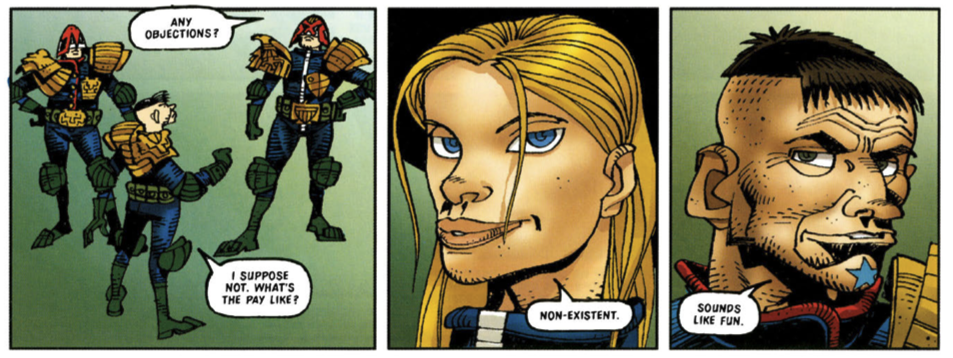
0:00:00-0:03:53: And so we return and begin again, with Jeff and I introducing ourselves and also the volume we’re talking about this time: Judge Dredd: The Complete Case Files Vol. 30. Written by John Wagner, the whole volume is, in theory, telling one singular — if complicated — story, with art from a whole host of talents, including Cam Kennedy, Mick McMahon, and Charlie Adlard. I also take this opportunity to call out a mistake in the credits of Vol. 30, which is honestly kind of impressive when you think about just how many credits have run in the preceding 29 volumes without mistake.
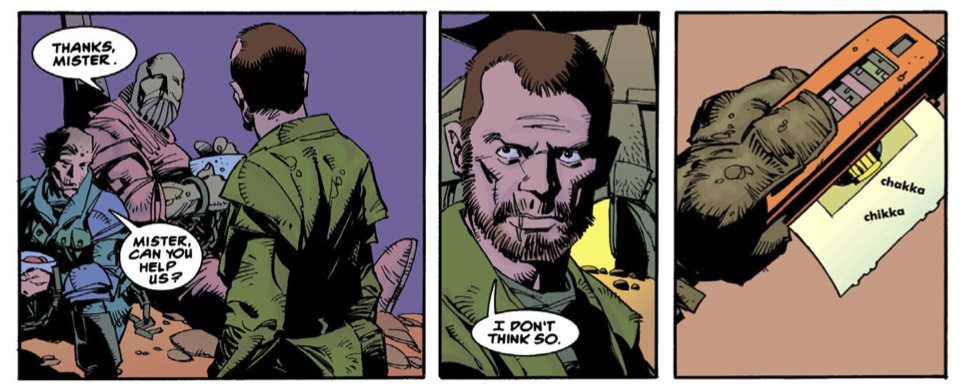
0:03:54-0:26:29: We immediately launch into a discussion about why the book disappoints, because it’s us. It’s not just that it’s uneven, but that the start of the volume is so strong that when Wagner starts losing interest, it’s very obvious. Jeff has theories about the ways in which the arc fails to live up to traditional Dredd mega-epic plotting, and also feels as if this arc is “The Apocalypse War” all over again (but worse); I’m unconvinced, pointing out that at least some of the traditional mega-epic structure shows up here. More of a problem for me is the fact that, as a crossover between the Megazine and 2000 AD, the way the story is collected in this volume hurts the material, which wasn’t that strong to begin with. Also! What is going on with the Judge Edgar non-plot thread in this story? And how great is Wagner when he goes minimal as he does on the first story in this collection?
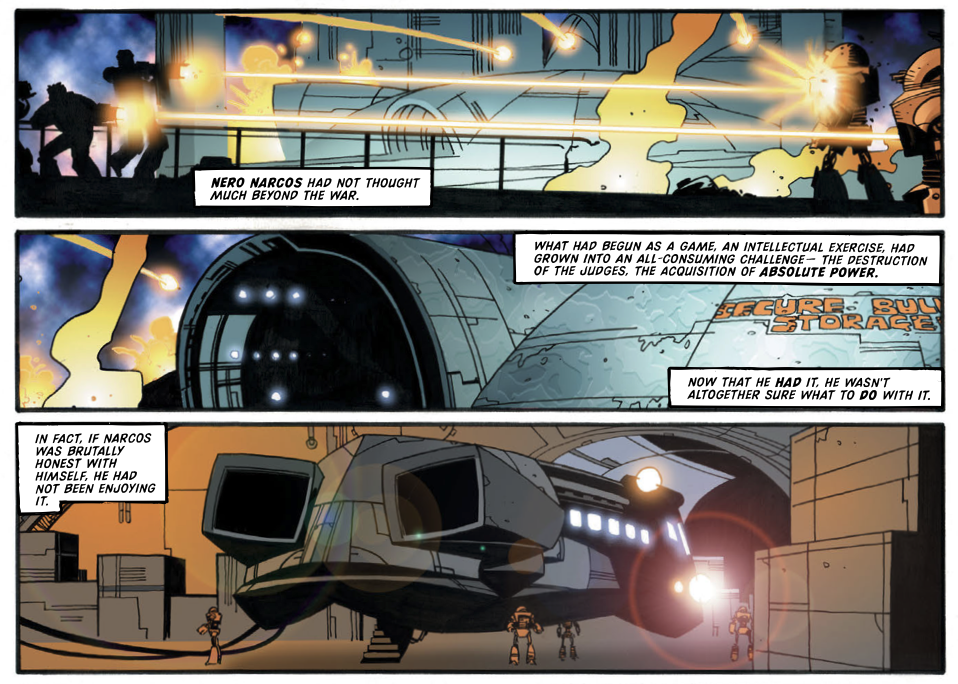
0:26:30-0:38:13: Our dissatisfaction tour continues, as we talk about the utter failure of Nero Narcos as the villain of the piece — something that even Wagner seems to have realized and accepted inside the text of this story itself, somewhat amazingly. He had the potential to be a mirror image of Dredd himself, but utterly failed on that front. (Except, and we didn’t discuss this on the podcast, what if his failing to live up to his potential and having no ability to stay on mission part of his opposite of Dredd-ness? Did I just blow your mind?!?) But did Wagner undercut things by making sure that the fall of Mega-City One happened off-panel — and could that have anything to do with what Jeff describes as Wagner having grown past the war comic genre?
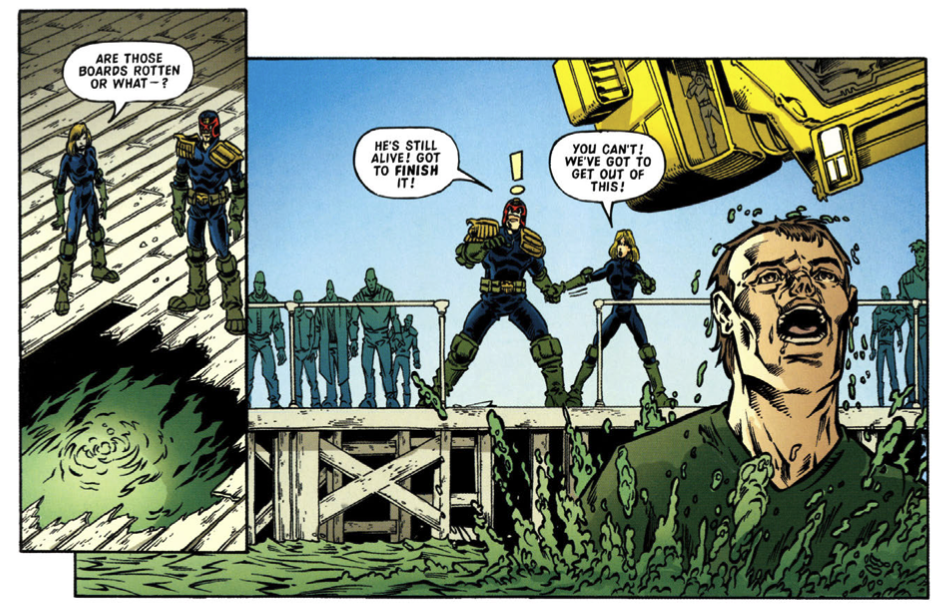
0:38:14-1:06:17: We return to how uneven the book is, and why the opening works on levels that the rest just can’t live up to. Is it Cam Kennedy’s art? (And Simon Davis’ art, too.) Or is there something about the tone of the writing that is abandoned to a cartoonish ness for the rest of the book, including the conclusion of the very trial story that Kennedy and Davis’ arcs are part of? Also, does the cheapness of Orlok’s escape speak to a structural problem with the strip having a recurring villain based around the idea of his being as tough as Dredd? Does the trial attempt to redeem Dredd’s actions in “The Apocalypse War” and speak to Wagner attempting to retcon Dredd into being less morally ambiguous, and more “Judge Dad”? Am I out of bounds by using future Dredd stories as guidelines for how I read this material? Did I completely and accidentally miss Jeff’s cue that he wanted to talk about DeMarco and instead talk about other stuff? Well, the answer to that last one is easy to answer: yes. (Oops.)
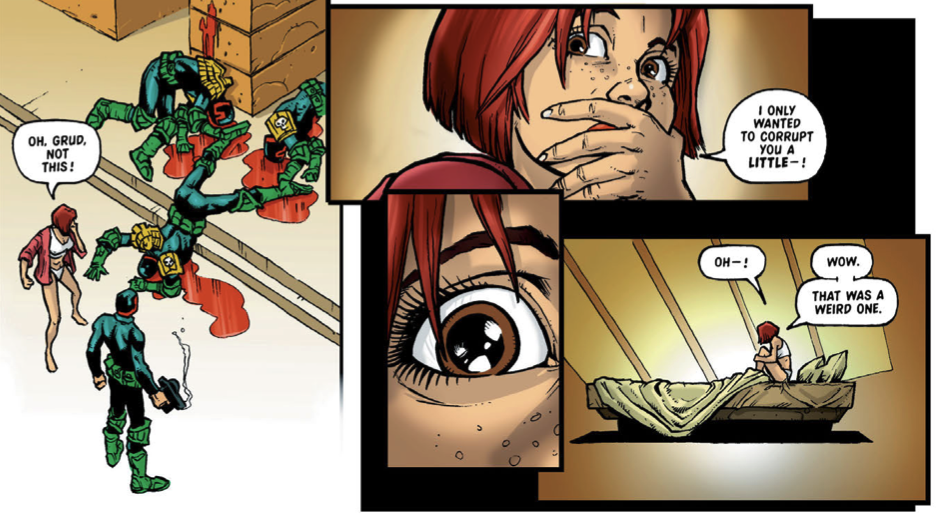
1:06:18-1:25:19: Finally, we get to the DeMarco conversation that Jeff wanted to have earlier, and it goes to unexpected places. That both of us feel that the DeMarco side of the story is a letdown, I’m pretty sure everyone saw coming, especially with Andrew Currie’s artwork failing to serve the story in any appreciable way. It’s similarly not too surprising that we were both disappointed by DeMarco running into two judges she’s previously worked with, or how broadly Rothman’s portrayal is in his brief appearances — for real, he would have been reprimanded for that kind of nonsense, surely…? — but who expected Jeff and I to get into a discussion over whether or not private eyes should exist in Mega-City One, or whether it’s a waste of the potential that DeMarco represents?
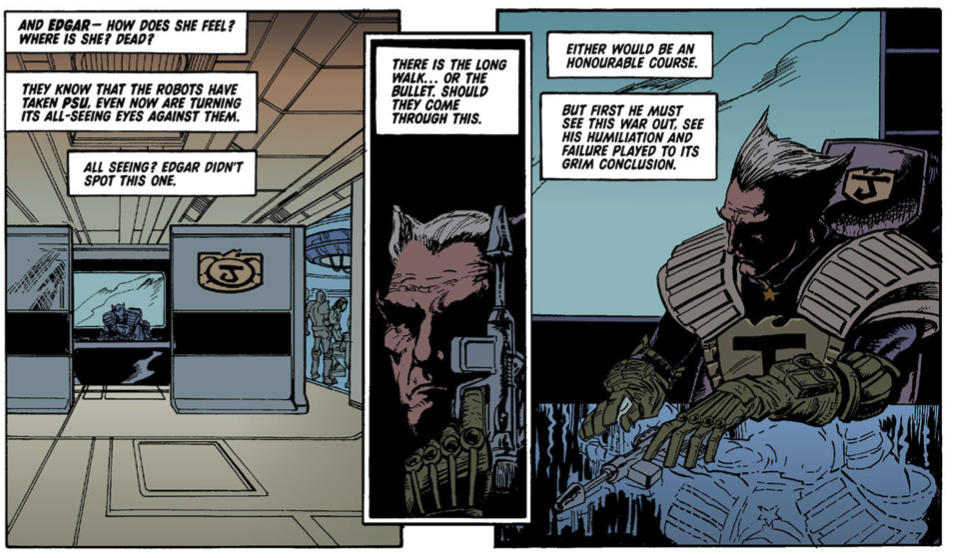
1:25:20-1:32:41: The unfortunate fate of Chief Judge Volt is briefly touched upon, with neither of us feeling as if it was particularly earned, nor necessary. Jeff talks about whether or not it’s part of an especially subtextual arc about Volt being a Dredd supporter, whereas I’m more concerned about the seeming overstatement about the importance of whether or not the Psi Division is responsible for the disaster, which comes up more than once in the story. I mean, they did see it coming…
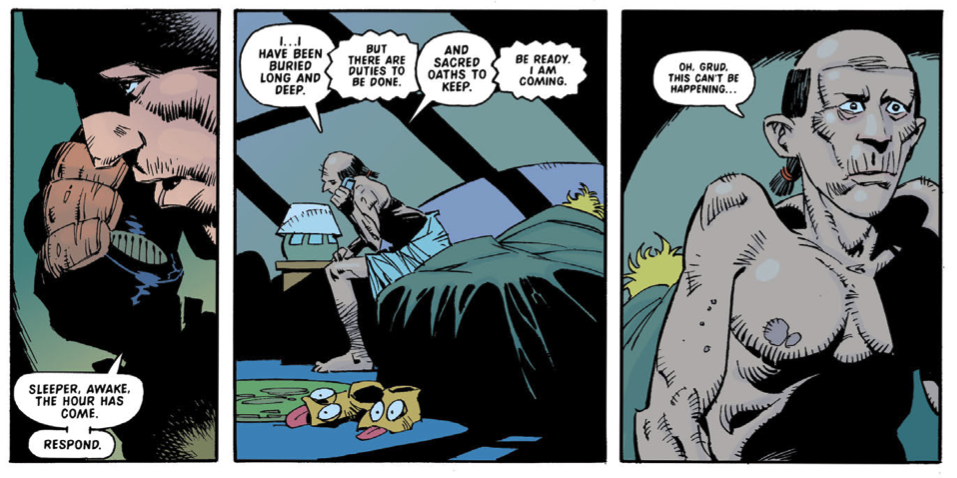
1:32:42-1:42:03: Before we try to close up shop, we talk a little bit about the art in the volume, which includes some genuinely incredible highs — Kennedy, McMahon, Colin Wilson doing some great work — and some utterly destructive swapping out of artists on the “War Games” sequence in particular, which has no less than six artists in seven chapters, and not exactly artists with similar styles.
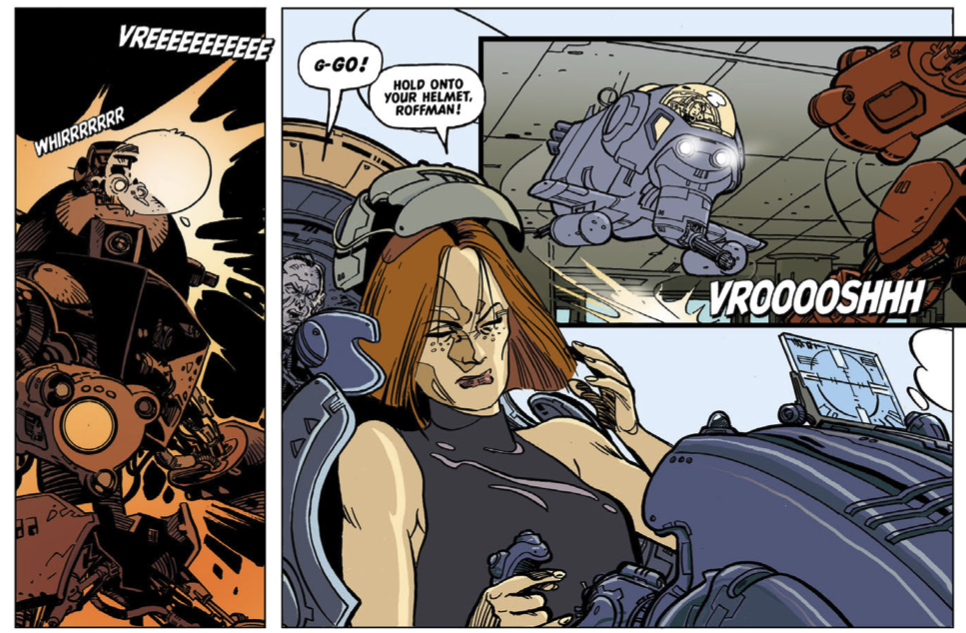
1:42:04-1:54:19: Drokk or Dross? We both go for Drokk ultimately, despite reservations, which comes as a surprise to me considering some of Jeff’s misgivings. We also talk about the anti-climactic climax to the entire storyline, and the fact that — because of the format of the crossover, and the way it’s collected here — you get to read it twice, just to ensure as much disappointment as possible.
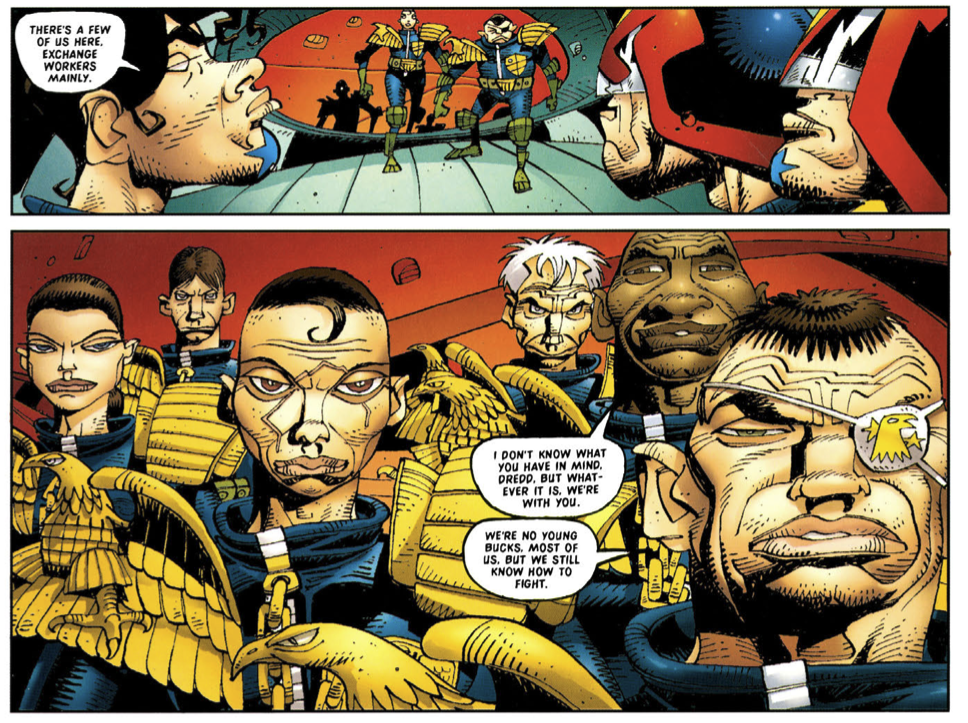
1:54:20-end: As we try and wrap things up, I throw a wrench in the works and suggest that next episode ignores Dredd entirely to, instead, read some Strontium Dog — another 2000AD series created by John Wagner and Carlos Ezquerra, and written for the majority of its run by the team of Wagner and Alan Grant — only for Jeff to agree, so: next time, we’ll be reading Strontium Dog: Search/Destroy Agency Files Vol. 2, and it’ll be a lot of fun. Also, we mention Patreon and Twitter, as usual, but that’s not as important as, next month! Strontium Dog! As always, thanks for listening.


What’s that you say? Direct link to the audio? That’d be… http://theworkingdraft.com/media/Drokk/DrokkEp33.mp3
I think, when our hosts were suggesting that Wagner was retconning the end of the Apocalypse War, they might have been misremembering it a little? It seemed to me, although I may have misunderstood what they were saying, that their point was that, when Anderson says that Dredd didn’t have a choice, that’s not how it was presented originally, and I had the sense that they were even saying that when Dredd nukes East-Meg One, he’s nuking an enemy who’s already defeated.
If so, I think that’s misremembering it. Here’s the caption at the opening of Apocalypse War episode 19: “By the eighth day of the Apocalypse War, 90% of the metropolis has fallen to the relentless advance of the East-Meg hordes.” Dredd’s team doing their final mission is that classic war story trope of all being lost, but then this one last desperate gamble turns everything around. One can of course say that there was a choice, to choose surrender rather than nuclear obliteration of the enemy, but I don’t think Anderson is being terribly inaccurate. In other words, Day of Chaos may well change the point of view on this, but Wagner is being consistent at this point with how he presented things in the original story.
Wagner is eliding one aspect of the ending of the Apocalypse War, though, because this story treats Anderson as a third party who’s not connected to what happened. But Dredd might have pushed the button, but he only had the codes in the first place because Anderson took them out of a Sov judge’s mind a couple of panels or so earlier — knowing full well what Dredd was going to do with them, one has to assume. If Dredd is guilty, Anderson is definitely an accessory, and none of the East-Meg one characters here, including Orlok, seem to give that any attention.
-But back to that whole thing about classic war story tropes. One thing about the Apocalypse War is that while in theory it’s analogous to a confrontation between the US and the Soviet Union, in practice it’s put together from things that had appeared over and over again in British comics about the Second World War.
Along those lines, I thought Jeff Lester’s comments about the Citi-Def people trying to re-enact war story tropes from media were very interesting. In the Apocalypse War (=WWII), we do see Citi-Def fighting alongside the judges. In other words, there the Citi-Def do actually do what they are theoretically for, in a straightforward and unproblematic way. Given that this story obviously has us comparing this assault on the city with the Apocalypse War, I don’t think it’s unreasonable to regard this as pointed.
And maybe even prescient? Because think about when this appeared. It was the height of “Greatest Generation” nostalgia, with Saving Private Ryan and so on. There was a recurrent emphasis in America on the question of “Could Americans today do what they did?” I think it’d be hard to deny that did a lot to dictate how the US reacted to 9/11, with a bunch of explicit comparisons to the challenge posed by World War II, media that saw its job as to rally patriotically around the President, the “Axis of Evil,” etc. The intense desire to cosplay the Second World War is not the least reason why the Iraq War happened.
Some more scattered thoughts:-
-While I do think it matters that the Apocalypse War = WWII, there is something post-Cold War about this story. The original Apocalypse War was written at a time when the assumption was that the Cold War would continue indefinitely. You can see the same thing in Arthur C. Clarke’s 2010 and other works from the time — there will always be the Soviet Union. So it makes sense that Wagner & Grant just projected that onto their imagined authoritarian future.
But *this* is appearing almost a decade after 1989. And while the details are obviously very different from real Russia, I think it matters that there is no new East-Meg One, just a remnant that is in no way an equal to Mega-City One (=the USA). This is a story about another country trying to bring an American before a non-American court — not an international one, but still, it is striking that 1998 is the year that it was agreed to establish the ICC, and the Mediterranean Free State has a certain appearance of being a sort of international community in miniature, with different nations jammed together.
Actually, the Mediterranean Free State would be a fun location for future Dredd stories, this warren of different jurisdictions floating on the water. I assume that Venice is part of the inspiration. The notion of a city of refugees was timely at the time — and still is, unfortunately.
And on the other hand, there is something post-Cold War (but pre=9/11) about the idea that what can threaten Mega-City One (=America) can’t come from without — it has to be a home-grown menace.
– I still think our hosts are going a little easy on Wagner’s basic concept of Galen DeMarco, It’s all very well to talk about some important conflict of principle with Dredd over judge emotional distance and celibacy, but Wagner is the person who is deciding that what you should do with DeMarco is have two extensive sequences in which we see her dreaming about having sex with Dredd. I agree that the art is sexualizing her; I’m pretty sure that is entirely in tune with Wagner’s intentions, or more accurately, in tune with this glimpse we are getting into Wagner’s psyche that I really wish we weren’t getting. Especially when Dredd talks about her father issues…
I like DeMarco as a character — this particular element, that she’s infatuated with a man that she is supposedly too perceptive not to realize is incapable of reciprocating her feelings, remains something that I have a horrible feeling was always supposed to be the main point of her. And all the things that I like? Those are the *inessential* features of DeMarco as a character.
– I wonder if a good approach to what is happening in Mega-City One would be to do *more* of the Blints and the comedy Citi-Def. Not them, specifically, but instead of following DeMarco and Roffman, expand the canvas to do “slices of life in Mega-City One” during the Narcos interregnum, and have DeMarco intersect with them? Check in on Mrs. Gunderson and the Quite Nice Bar.
– Orlok in the first issue is starring in a pretty damn good Strontium Dog story, really.
:ooking forward a *lot* to next month, especially what Jeff Lester will make of what was my personal favorite strip in 2000 AD when I was a child. The second volume of the S/D A Files starts with Portrait of a Mutant — the Starlord material in volume 1 is indeed pretty indifferent at best, but the second halfish of volume 1 is 2000 AD and contains some great stuff. In an ideal world, I’d say dip into volume 1 to read The Schicklgruber Grab, to which Graeme McMillan referred in the last episode, which is sort of the Platonic ideal of what a classic Strontium Dog story is — not the best by any means, but the most Strontium Doggy, as it were. And then maybe sample a few other things from the second half of vol. 1, and then read Portrait of a Mutant so that one can appreciate how different it is from the normal Strontium Dog routine.
But Jeff Lester is not made of money and time, and if you’re going to read only one volume, it sort of has to be volume 2. I’ll be really interested to hear how he and Graeme McMillan think Portrait of a Mutant compares to the Apocalypse War. Two extended stories, from the same creators, both early ‘80s.
Funnily enough I was going to suggest after hearing that Jeff had still yet to read Strontium Dog in the last regular podcast that you do a special called “Sneck!”. As ever, look forward to hearing your thoughts.
Woo! I love to hear you both talk about Judge Dredd, obviously, but I had been on the fence about picking up S/D volume 2, so now I have a good reason to do so!
Same! :-)
I think it’s interesting how much Wagner loses almost all interest in two things at the end of this storyline, and they do make it feel like the end of a particular era.
The first is obvious enough – Wagner has lost interest in mega-epics before, but after this he doesn’t do another one for more than a decade until Day of Chaos, and nothing after that for another 10 years and counting. He does a few 10-12 part stories and messed around for a long time with the mutant laws/Tour of Duty stuff, but there has only been one full-blown mega epic by Wagner in the past 20 years. Fair enough, they look really hard.
But it’s also kind of shocking how much he instantly loses interest in DeMarco – I can’t think of a single Wagner story that features her after this. She gets her own series with a talking ape by various writers who are not John Wagner, but it doesn’t really go anywhere and she loses her fortune and ends up as a supporting character in The Simping Detective. After all the work Wagner did with her in the years leading up to this volume, it’s pretty cold how much he moves on.
There are a couple more Strong Young Women – one a judge of the next generation and the other with a family connection – that will have Dredd’s attention in the following years and obviously follow in her footsteps, but they have stuck around a lot longer than Demarco ever did. It’s just weird how quickly and permanently she is out.
At least the art in this book is good when it’s good.
Bring on the dog!
Despite all the flaws, which you both brilliantly encapsulated, this volume was definitely Drokk in my book. The 2000 A.D. portion really felt incomplete. I almost wish they had done it the old-school Marvel crossover way wherein 2000 A.D. would have given you the full and complete story, and the Megazine would have given you some of the side stories that were alluded to but never full explored yet not necessary reading for the main event. I felt both happy that the DeMarco Megazine strips would clarify some of the less well illuminated part of the front half, but severely disappointed that it would also be disjointed and unsatisfying.
Had it been up to me, I would have made this one complete story. Ignoring the issues with Narcos, I think this would have worked better with more zigs and zags instead of the tried and true low-grade mystery format of withholding key information from the reader. I would have liked to see it start with DeMarco investigating her first private case, maybe reaching out to the judges who spurn her for either not knowing her or not trusting her. She gets in trouble. Dredd steps in but isn’t sure he should help her or arrest her. Meanwhile Orlock’s story is playing out in the background, slowly building. Just when DeMarco and Dredd are a step or two from piecing Narcos’s plan together, Orlock strikes and removes Dredd from the stage, leaving DeMarco to impotently attempt to convince the judges of what’s about to happen (which would help with Volt’s arc as well). We see some Mark II’s exploding and some bots approaching the city and attacking judges, but then it’s off to the trial. I think something like that where all the threads are better integrated would have been better by far.
-Even given the number of robots, how did they take over the entire eastern seaboard of the U.S.? There definitely weren’t that many. It’s kind of annoying how the scale of MC1 expands and contrasts to suit the story. Dredd seems to be permanently affixed to the area around where NYC would have been. Why not put him down in the former George or South Carolina section of MC!? I guess Dredd is alway 5 minutes away from wherever he needs to be.
-Haven’t we seen East-Meg judges before, or were they from other Megs in the former Soviet Union. Feels like a bit of retcon to say they’re the only ones left. If MC1 got wiped out, wouldn’t Dredd just go to MC2 or the Texas one?
-How many citizens are actually left in MC1? There can’t be even 50 mil at this point. After Apocalypse War, Necropolis, that terrible Morrison story with the guy raising the dead, and a hundred other natural disasters and whatnot, there’s no way they could have replenished that population. Guess that’s one of those things we’re not meant to pay too close attention to.
-Like Jeff, I have an instant revulsion to the idea of PIs in this universe and I can’t explain why. Maybe the last volume where they had a Wally Squad judge posting as a lawyer (another unnecessary profession in MC!), that I just agree with Jeff that the judges and their system have supplanted too much to the point they obviate the need for these things. I can’t imagine the judges would want unsanctioned cits playing at their job.
-Shame to hear this is the last DeMarco story. She really could have been an interesting foil to the judge system.
-When will these Angel of Death stories end? I’m really growing tired of them. I tolerated the P.J. Maybe stories, and the payoff was OKish, but I feel this Angel of Death story is going nowhere. Unless she teams up with Judge Death in the future?
-Glad to see Orlock! Unlike the Sopranos, Judge Dredd has no problem showing us what happened to the Russian. But did I miss where he and Anderson had adventures together? Did Graeme mention if that happened in the Anderson strips, or were we meant to infer that? If that latter, kudos to Wagner, because I felt like was told everything I needed.
-Orlock mentions that Anderson has aged, but Kennedy is the only artist in this book who draws her in her maturity. Everyone else is trying to keep her 20 years old.
-Wow, Charlie Adlard used to be better! And draw characters who looked different!
-The end of the story did remind me of Apocalypse Was in that you had a small cadre of judges, led by Dredd, infiltrating the enemy’s territory and using its weapons against him.
-Was Narco meant to be a Moriarty for Dredd’s Sherlock? I feel like P.J. Maybe was too but never lived up to that potential. I guess the closest we’ve had in that respect was the Hunter’s Club.
-The musical chairs artists every 8 pages did not help. Made me miss the old days when it was just Smith, Bolland, McMahon, and Ezquerra.
-I laughed out loud at that one line of shade thrown at Canada, the Canadian Wastelands or something. Was that the first mention of Canada in Dredd?
Strontium Dog… Not sure if I’m ready for that. I’m still not over my shock that SD is a person and not, you know, an actual dog.
Well if this volume doesn’t rate as a Dross, then I think its safe to say there won’t be a Dross for the rest of the series, because this was rubbish.
Sorry this spicy take got caught in the filter but I’m excited to see it. Feel free to weigh in with reasons, if you wish.
To me its telling that the best thing you can say about the Narcos storyline is that it reminds you of a better mega epic (Day of Chaos). As you both said, the art is good in places, but inconsistent, so the visuals can’t redeem the story, and Wagner gets bored of his villain and his story while telling it and it shows. But this is the main story. All the great quality set up of the previous stories and the previous Narcos appearances lead up this. And in the end its a better drawn City of the Damned, and at least that story gave us the lasting character point of Dredd having bionic eyes.
If Return of the Assassin and the trial storyline were independent of Doomsday, I think you could push for the Drokk with asterix assessment. But to me because they serve as a direct prelude the “Second Robot War” storyline they are tainted by association.
And this isn’t deep insight, you both talked about it in the episode, but when you gave your final judgement it got a Drokk!